#Apollo Block I Command and Service Module
Explore tagged Tumblr posts
Text
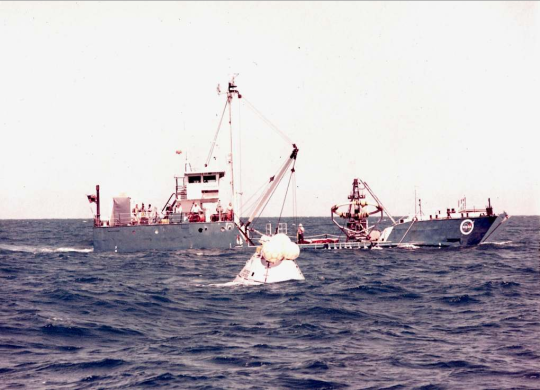
"Apollo Command Module CSM-007A near NASA's MV Retriever in the Gulf of Mexico, during a manned 48-hour Apollo Block II Command Module postlanding systems qualification test."
CM-007 was delivered to NASA in 1966. After serving as a ground test vehicle, CM-007 was modified in 1967 for use in water-survival training as CM-007A. As part of their training, the astronauts inside the capsule were dropped into the Gulf of Mexico by a crane from an aircraft carrier to simulate the force of splashdown. Apollo crews also trained for extended recovery by remaining at sea for several days at a time in the Command Module. Such training prepared astronauts for the possibility of a splashdown far from the planned recovery site.
Date: April 5, 1968
NASA ID: S68-30160
#CSM-007#CM-007A#Apollo Program#Apollo Block I Command and Service Module#Command Module#NASA#Gulf of Mexico#April#1968#my post
42 notes
·
View notes
Text


Latest moon mission carries a new reflection on history
In July 1969, four faculty members traveled from College Park to Kennedy Space Center in Florida to provide last-minute instruction to a noteworthy pupil: an Apollo 11 astronaut about to become one of the first humans to set foot beyond Earth.
Just days later, lunar module pilot Buzz Aldrin would be following mission commander Neil Armstrong onto the moon's surface to deploy a UMD-led experiment. The suitcase-size array of retroreflectors—painstakingly crafted hunks of glass able to reflect light directly back to its source from any angle—would serve as a target for powerful lasers on Earth and provide the first accurate measurements of the distance between the planet and its satellite. In a meeting with Aldrin, then-Assistant Professor Douglas Currie, an expert in laser light, asked if the former fighter pilot with a Ph.D. in astronautics had any questions.
At a later lunar workshop, Currie recalls, Aldrin scoffed about the procedural instructions, "Ahh, it was so easy I decided I could give it to Armstrong."
But the wisecracking astronaut had done his homework, and for the last 55 years, that array and two more placed by successive Apollo missions have yielded a wealth of data for NASA's Lunar Laser Ranging experiment, helping scientists detect our moon's liquid core, bolstering Einstein's theory of general relativity and providing a better understanding of the evolution of the Earth-moon system, among other discoveries.
Now the university has done it again with the launch early Wednesday of the Next Generation Lunar Retroreflector as part of a mission scheduled to touch down on the moon on March 2. This time, Currie is principal investigator for the retroreflector project, a position held on the Apollo 11 project by the late physics Professor Carroll Alley.
There are no astronauts to train for this mission; the chunky "corner cube" retroreflector will arrive aboard an uncrewed craft launched by the company Firefly Aerospace as part of NASA's Commercial Lunar Payload Services program and remain atop the lander for its operational life. (Subsequent reflectors to be developed by NASA with UMD's help, based on Currie's general design, are expected to be set up by astronauts in NASA's Artemis program, which aims to return to the moon later this decade.)
"When NASA announced back in 2004 they were going back to the moon, I said that instead of an array of 100, we need to have one big one, and I've been playing with that since then," says Currie, now a professor emeritus and senior research scientist in the Department of Physics.
He and NASA hope the next-gen device boosts precision in distance measurements by perhaps a factor of 30, from several centimeters of uncertainty to less than one millimeter.
The imprecision of the current device stems from the fact that observers watching from the ground don't know if a laser pulse bounces back from a reflector on the near corner or the far corner of the array, which are at slightly different and constantly changing distances from the ground because of the moon's slight back-and-forth movement relative to Earth. Having just one mirror removes uncertainty, Currie says.
The new setup will also have the advantage of being shiny and new. Though still functional, evidence suggests the Apollo 11 mission array is significantly blocked by lunar dust; calculations suggest the new device will be 10 times as bright as the current arrays, says Stephen Merkowitz, who's overseeing lunar laser ranging as Space Geodesy Project manager at NASA Goddard Space Flight Center.
Solving these problems will contribute to another one, however. The hefty chunk of glass making up the new single retroreflector mirror soaks up and sheds more heat during frigid lunar nights and blazing days, creating a greater possibility for temperature gradients and distorted reflections. Currie and his partners at the National Laboratories of Frascati in Italy worked to minimize that with the retroreflector's housing design.
"A lot of what we're looking to do today builds directly on what was done more than 50 years ago, so Doug's experience working on Apollo is valuable in the present," Merkowitz says.
Currie chuckles looking at a photo he keeps in his office in the Physics Building: It shows Aldrin strolling across the moon, swinging the original UMD mirror array in one hand and another priceless experiment in another. Times have changed.
"Now we're told the astronauts have to carry it in both hands, even though it weighs only a fraction of what Buzz was carrying," he says. "They want you to do one thing at a time, I guess."
TOP IMAGE: Currie’s modern mirror design awaits thermal testing in a chamber at NASA Goddard Space Flight Center. Credit: University of Maryland
LOWER IMAGE: During the Apollo 11 mission, astronaut Buzz Aldrin carries experiments including a lunar reflector designed by Douglas Currie and other UMD faculty. Credit: Douglas Currie
5 notes
·
View notes
Text
Remember the Women Who Made #Apollo50th Possible
As the world celebrates the 50th anniversary of the historic Moon landing, we remember some of the women whose hard work and ingenuity made it possible. The women featured here represent just a small fraction of the enormous contributions made by women during the Apollo era.
Margaret Hamilton, Computer Programmer
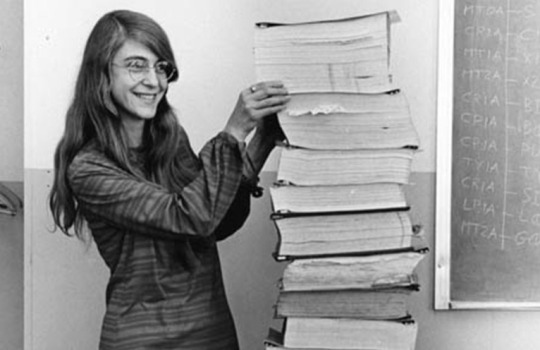
Margaret Hamilton led the team that developed the building blocks of software engineering — a term that she coined herself. Her systems approach to the Apollo software development and insistence on rigorous testing was critical to the success of Apollo. In fact, the Apollo guidance software was so robust that no software bugs were found on any crewed Apollo missions, and it was adapted for use in Skylab, the Space Shuttle and the first digital fly-by-wire systems in aircraft.
In this photo, Hamilton stands next to a stack of Apollo Guidance Computer source code. As she noted, “There was no second chance. We all knew that.”
Katherine Johnson, Aerospace Technologist
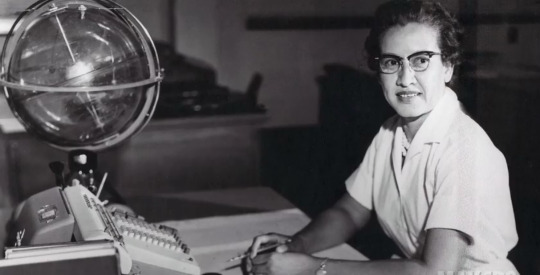
As a very young girl, Katherine Johnson loved to count things. She counted everything, from the number of steps she took to get to the road to the number of forks and plates she washed when doing the dishes.
As an adult, Johnson became a “human computer” for the National Advisory Committee for Aeronautics, which in 1958, became NASA. Her calculations were crucial to syncing Apollo’s Lunar Lander with the Moon-orbiting Command and Service Module. “I went to work every day for 33 years happy. Never did I get up and say I don't want to go to work."
Judy Sullivan, Biomedical Engineer
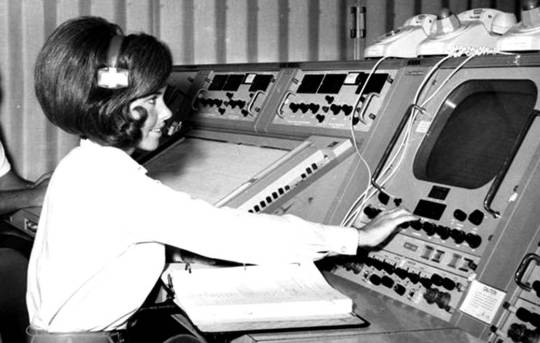
This fabulous flip belongs to biomedical engineer Judy Sullivan, who monitored the vital signs of the Apollo 11 astronauts throughout their spaceflight training via small sensors attached to their bodies. On July 16, 1969, she was the only woman in the suit lab as the team helped Neil Armstrong suit up for launch.
Sullivan appeared on the game show “To Tell the Truth,” in which a celebrity panel had to guess which of the female contestants was a biomedical engineer. Her choice to wear a short, ruffled skirt stumped everyone and won her a $500 prize. In this photo, Sullivan monitors a console during a training exercise for the first lunar landing mission.
Billie Robertson, Mathematician
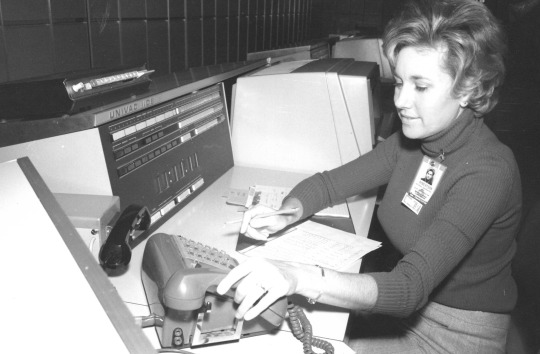
Billie Robertson, pictured here in 1972 running a real-time go-no-go simulation for the Apollo 17 mission, originally intended to become a math teacher. Instead, she worked with the Army Ballistic Missile Agency, which later became rolled into NASA. She created the manual for running computer models that were used to simulate launches for the Apollo, Skylab and Apollo Soyuz Test Project programs.
Robertson regularly visited local schools over the course of her career, empowering young women to pursue careers in STEM and aerospace.
Mary Jackson, Aeronautical Engineer
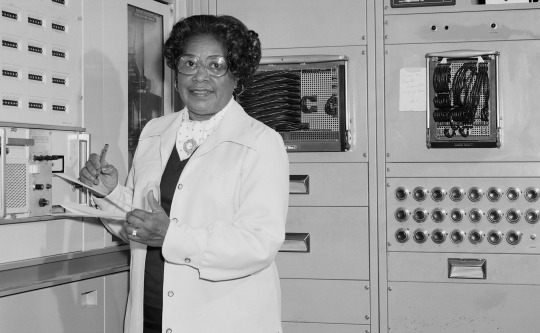
In 1958, Mary Jackson became NASA’s first African-American female engineer. Her engineering specialty was the extremely complex field of boundary layer effects on aerospace vehicles at supersonic speeds.
In the 1970s, Jackson helped the students at Hampton’s King Street Community center build their own wind tunnel and use it to conduct experiments. “We have to do something like this to get them interested in science," she said for the local newspaper. "Sometimes they are not aware of the number of black scientists, and don't even know of the career opportunities until it is too late."
Ethel Heinecke Bauer, Aerospace Engineer
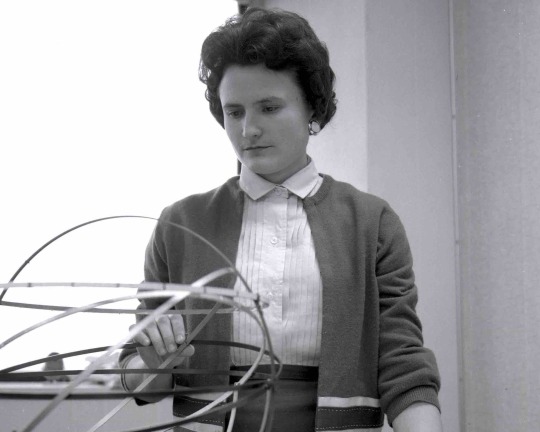
After watching the launch of Sputnik in October 1957, Ethel Heinecke Bauer changed her major to mathematics. Over her 32 years at NASA, she worked at two different centers in mathematics, aerospace engineering, development and more.
Bauer planned the lunar trajectories for the Apollo program including the ‘free return’ trajectory which allowed for a safe return in the event of a systems failure — a trajectory used on Apollo 13, as well as the first three Apollo flights to the Moon. In the above photo, Bauer works on trajectories with the help of an orbital model.
Follow Women@NASA for more stories like this one, and make sure to follow us on Tumblr for your regular dose of space: http://nasa.tumblr.com.
#apollo 11#apollo50th#women in STEM#history#nasa#space#women of NASA#Moon#Moon landing#lunar landing#STEM#mathematics#aerospace#apollo
15K notes
·
View notes
Photo

Today in 1966, AS-201 launched on the first unpiloted, suborbital flight of a Block I Apollo Command/Service Module on a Saturn IB launch vehicle.
#nasa#space#apollo#saturnv#saturn v#space program#science#space news#technology#research#scientist#spaceflight#spacecraft
1 note
·
View note
Text

There’s a first time for everything! AS-201 blasts off as the 1st unmanned test flight of the Saturn 1B rocket with the Block I Apollo Command & Service Module, Feb 1966. The 37-minute suborbital flight was a successful demonstration of the CM’s heat shield ability during re-entry. The mission occurred before NASA had decided upon the Lunar Module rendezvous method in space; hence the CSM on this flight lacked the ability to dock with a LM.
#nasa#aerospace#saturn rocket#blast off#space travel#space exploration#apollo program#space race#rocket launch#project apollo#launch pad#rocket science#space#astronauts#astronaut#vintage space#1966#space age#1960s#rocket scientist#Saturn 1b
40 notes
·
View notes
Text
Events 4.21
753 BC – Romulus founds Rome (traditional date). 43 BC – Battle of Mutina: Mark Antony is again defeated in battle by Aulus Hirtius, who is killed. Antony fails to capture Mutina and Decimus Brutus is murdered shortly after. 900 – The Laguna Copperplate Inscription (the earliest known written document found in what is now the Philippines): the Commander-in-Chief of the Kingdom of Tondo, as represented by the Honourable Jayadewa, Lord Minister of Pailah, pardons from all debt the Honourable Namwaran and his relations. 1092 – The Diocese of Pisa is elevated to the rank of metropolitan archdiocese by Pope Urban II 1506 – The three-day Lisbon Massacre comes to an end with the slaughter of over 1,900 suspected Jews by Portuguese Catholics. 1509 – Henry VIII ascends the throne of England on the death of his father, Henry VII. 1526 – The last ruler of the Lodi dynasty, Ibrahim Lodi is defeated and killed by Babur in the First Battle of Panipat. 1615 – The Wignacourt Aqueduct is inaugurated in Malta. 1782 – The city of Rattanakosin, now known internationally as Bangkok, is founded on the eastern bank of the Chao Phraya River by King Buddha Yodfa Chulaloke. 1789 – John Adams sworn in as 1st US Vice President (nine days before George Washington) 1789 – George Washington's reception at Trenton is hosted by the Ladies of Trenton as he journeys to New York City for his first inauguration. 1792 – Tiradentes, a revolutionary leading a movement for Brazil's independence, is hanged, drawn and quartered. 1802 – Twelve thousand Wahhabis sack Karbala, killing over three thousand inhabitants. 1806 – Action of 21 April 1806: A French frigate escapes British forces off the coast of South Africa. 1809 – Two Austrian army corps are driven from Landshut by a First French Empire army led by Napoleon as two French corps to the north hold off the main Austrian army on the first day of the Battle of Eckmühl. 1821 – Benderli Ali Pasha arrives in Constantinople as the new Grand Vizier of the Ottoman Empire; he remains in power for only nine days before being sent into exile. 1836 – Texas Revolution: The Battle of San Jacinto: Republic of Texas forces under Sam Houston defeat troops under Mexican General Antonio López de Santa Anna. 1856 – Australian labour movement: Stonemasons and building workers on building sites around Melbourne march from the University of Melbourne to Parliament House to achieve an eight-hour day. 1894 – Norway formally adopts the Krag–Jørgensen bolt-action rifle as the main arm of its armed forces, a weapon that would remain in service for almost 50 years. 1898 – Spanish–American War: The United States Navy begins a blockade of Cuban ports. When the U.S. Congress issued a declaration of war on April 25, it declared that a state of war had existed from this date. 1914 – Ypiranga incident: A German arms shipment to Mexico is intercepted by the U.S. Navy near Veracruz. 1918 – World War I: German fighter ace Manfred von Richthofen, better known as "The Red Baron", is shot down and killed over Vaux-sur-Somme in France. 1926 – Al-Baqi cemetery, former site of the mausoleum of four Shi'a Imams, is leveled to the ground by Wahhabis. 1934 – The "Surgeon's Photograph", the most famous photo allegedly showing the Loch Ness Monster, is published in the Daily Mail (in 1999, it is revealed to be a hoax). 1945 – World War II: Soviet forces south of Berlin at Zossen attack the German High Command headquarters. 1948 – United Nations Security Council Resolution 47 relating to Kashmir conflict is adopted. 1952 – Secretary's Day (now Administrative Professionals' Day) is first celebrated. 1958 – United Airlines Flight 736 collides with a United States Air Force fighter jet near Arden, Nevada in what is now Enterprise, Nevada. 1960 – Brasília, Brazil's capital, is officially inaugurated. At 09:30, the Three Powers of the Republic are simultaneously transferred from the old capital, Rio de Janeiro. 1962 – The Seattle World's Fair (Century 21 Exposition) opens. It is the first World's Fair in the United States since World War II. 1963 – The first election of the Universal House of Justice is held, marking its establishment as the supreme governing institution of the Baháʼí Faith. 1964 – A Transit-5bn satellite fails to reach orbit after launch; as it re-enters the atmosphere, 2.1 pounds (0.95 kg) of radioactive plutonium in its SNAP RTG power source is widely dispersed. 1965 – The 1964–1965 New York World's Fair opens for its second and final season. 1966 – Rastafari movement: Haile Selassie of Ethiopia visits Jamaica, an event now celebrated as Grounation Day. 1967 – A few days before the general election in Greece, Colonel George Papadopoulos leads a coup d'état, establishing a military regime that lasts for seven years. 1972 – Astronauts John Young and Charles Duke fly Apollo 16's Apollo Lunar Module to the Moon's surface, the fifth NASA Apollo Program crewed lunar landing. 1975 – Vietnam War: President of South Vietnam Nguyễn Văn Thiệu flees Saigon, as Xuân Lộc, the last South Vietnamese outpost blocking a direct North Vietnamese assault on Saigon, falls. 1977 – Annie opens on Broadway. 1982 – Baseball: Rollie Fingers of the Milwaukee Brewers becomes the first pitcher to record 300 saves. 1985 – The compound of the militant group The Covenant, The Sword, and the Arm of the Lord surrenders to federal authorities in Arkansas after a two-day government siege. 1987 – The Tamil Tigers are blamed for a car bomb that detonates in the Sri Lankan capital city of Colombo, killing 106 people. 1989 – Tiananmen Square protests of 1989: In Beijing, around 100,000 students gather in Tiananmen Square to commemorate Chinese reform leader Hu Yaobang. 1993 – The Supreme Court in La Paz, Bolivia, sentences former dictator Luis García Meza to 30 years in jail without parole for murder, theft, fraud and violating the constitution. 2004 – Five suicide car bombers target police stations in and around Basra, killing 74 people and wounding 160. 2010 – The controversial Kharkiv Pact (Russian Ukrainian Naval Base for Gas Treaty) is signed in Kharkiv, Ukraine, by Ukrainian President Viktor Yanukovych and Russian President Dmitry Medvedev; it was unilaterally terminated by Russia on March 31, 2014. 2012 – Two trains are involved in a head-on collision near Sloterdijk, Amsterdam, in the Netherlands, injuring 116 people. 2014 – The American city of Flint, Michigan switches its water source to the Flint River, beginning the ongoing Flint water crisis which has caused lead poisoning in up to 12,000 people, and 15 deaths from Legionnaires disease, ultimately leading to criminal indictments against 15 people, five of whom have been charged with involuntary manslaughter. 2019 – Eight bombs explode at churches, hotels, and other locations in Sri Lanka on Easter Sunday; more than 250 people are killed.
1 note
·
View note
Video
youtube
Apollo 11 Moon Mission
“Well I made this complete Apollo 11 Saturn V replica for the Apollo 50th anniversary” -Tyrenol
Bringing Space Engineers back to the roots of space travel.
Tyrenol has some fun facts about his rocket build:
It is a full replica, complete interiors
It has all the stages the real one has (the lander even has 2 stages)
All crew compartments are airtight
It is 150 meters+ high
It has working (Small grid) hatches and doors
It is almost 100% small block except for some of the big thrusters
It can house 3 crew-members
The only thing that returns to earth is the command module on the top (above the service module)
The lander has a "TV cam" and a laser antenna so you can watch the first steps and landing from earth-like
It has 2 flight computers(one on the rocket one on the lander) that use commands to control thrust on the (large) thrusters
It is almost to scale
Download the Saturn V in Steam Workshop HERE.
Give Tyrenol’s Steam Workshop and YouTube a subscribe
0 notes
Text
NASA, SpaceX Gear Up for Historic Crewed Launch Today
NASA and SpaceX are just hours away from making history. After years of development and testing, SpaceX is set to become the first private spaceflight firm to carry American astronauts into space as part of NASA’s Commercial Crew Program. This is also the first crewed launch from US soil since the retirement of the Space Shuttle, a long-overdue step that will free NASA from reliance on Russian Soyuz launches. With the big moment approaching, we chatted with former astronauts Cady Coleman and Nicole Stott, both veterans of multiple Space Shuttle launches, to see how they felt about the return of crewed spaceflight to the US. Spoiler: pretty excited.
How We Got Here
SpaceX has moved quickly to develop the technology that makes its launch platform suitable for NASA service — it’s providing both the rocket (Falcon 9) and crew module (Dragon) for these launches. Former astronaut and retired USAF Colonel Cady Coleman says that has a lot to do with the way a private aerospace firm operates. “It’s a different world now. If you think back to the early space program, the government really was the designer. Working together [with private firms] is more necessary than it ever was because of the ability that commercial companies have. They can take bigger risks with [developing] hardware.”
SpaceX didn’t get here on its own, though. “The SpaceX team has had access all along to the lessons learned from NASA’s other programs,” says former astronaut Nicole Stott. “That’s a real advantage when going into a new project. When we have public-private partnerships, we can avoid re-learning the same lessons.”
Today’s launch is primarily about the Crew Dragon capsule, sometimes called Dragon 2. This is the same type of spacecraft that SpaceX used in last year’s uncrewed Demo Mission-1. Unfortunately, that craft exploded when it was undergoing testing back on Earth. SpaceX and NASA had to push back the launch timeline, but all systems are go just a year later. That might seem fast to an outside observer, but both Coleman and Stott expressed great confidence in the way NASA and its commercial crew partners have worked together. “We’ve always had a ‘here’s how we can’ not ‘here’s why we can’t’ approach,” says Coleman.
The launch
Today’s launch, known as Demo Mission 2 (DM-2), will take place on the historic launch pad 39A at Kennedy Space Center. SpaceX is using a Falcon 9 Block 5 design, the same rocket the company uses for cargo missions on a regular basis. This core in particular (B1058) has never been launched before, but SpaceX will try to land it on its drone ship after it detaches from the Dragon.
If all goes to plan, the Falcon 9 carrying astronauts Doug Hurley and Bob Behnken will leave the launchpad at 4:33 PM EDT. This launch will differ from past crewed missions in several ways, and it took time for SpaceX and NASA to come together on the details. “In getting ready for launch, there are some things that are just a given,” says Coleman. “NASA has done this and that forever, but SpaceX says ‘we’re not doing it that way.’ And some of that is maybe not well-thought-out, and some of that is actually a really good new idea.”
Unlike previous NASA crewed launches, SpaceX will fuel the Falcon 9 after Hurley and Behnken board the spacecraft. The launch and approach to the ISS will be automated like the Demo-1 mission last year, but Hurley and Behnken will still have the option to manually control the capsule. According to Nicole Stott, that wasn’t SpaceX’s intention at the outset.
“For a long time, SpaceX as a company thought they wouldn’t need those manual backups anymore — you know, we can do everything redundantly with the electronics in the spacecraft,” she said. “Maybe at some point we’ll get there, but I think when there are humans in the spacecraft, we’re looking for that manual backup.”
Robert Behnken (left) and Douglas Hurley (right)
While the Dragon 2 has superficial similarities to the older capsule-based spacecraft like the Apollo command module and Soyuz, it’s a much more futuristic design. Nicole Stott describes it as having a “new car feel” with a “simple elegance.” Stott says the Space Shuttle cockpit had displays, switches, and circuit breakers almost surrounding the crew. By comparison, the Dragon 2 has a few large touchscreens and compact manual controls.
After reaching orbit, Hurley and Behnken will be able to remove their restraints and float around the capsule. As this is a demo mission, NASA will most likely have an array of tasks for the crew to complete as they monitor the Dragon’s performance. Just like the ascent, rendezvous and docking will be controlled autonomously by the Dragon. After a brief stay aboard the ISS, Hurley and Behnken will return to Earth in the Dragon.
The Crew Dragon should splash down in the Atlantic Ocean with parachutes, which SpaceX tested one final time early this month. The Dragon capsule technically has the ability to land propulsively with its SuperDraco engines, which also power the launch abort system. However, NASA opted for the tried-and-true parachute option. That’s not to say SpaceX will never have a chance to use those engines for landing.
“I think we’re going to continue looking at [propulsive landings] as an option,” says Stott. “When you get into reduced gravity environments like landing on the moon or on Mars, we’ve done that in the past. I think we’re looking at what makes the most sense with the time we have available.” Essentially, NASA needs a reliable US spacecraft now, and we know parachutes work.
The future
After the completion of DM-2, the Crew Dragon will be ready to ferry astronauts to and from the ISS on a regular basis. Of course, that assumes everything goes well. Spaceflight is dangerous, even more so when it’s a new spacecraft. Both SpaceX and NASA have maintained a positive outlook — NASA actually chose to publicize the overall Loss Of Crew (LOC) risk of 1 in 276. Prior to the first Space Shuttle launch, the agency’s engineers estimated the LOC as at least 1 in 500. After reviewing real mission data, they said it was probably closer to 1 in 12. By the end of the Shuttle program, it was 1 in 90.
We can only hope that the mission is a complete success and these launches become non-events — astronauts just hop on their space bus and commute to the ISS. But today, Hurley and Behnken are making history. Nicole Stott put it succinctly, saying, “They’re setting off a new era of getting back into space from the US, helping us expand what we do with all our partners in space. And as always, with the goal of improving life here on Earth.”
This historic launch will take place at 4:33 PM EDT today with live streams from both NASA and SpaceX. National Geographic and ABC News will also have two hours of live coverage starting at 3 PM EDT today on “Launch America: Mission to Space,” featuring Cady Coleman among others. In the event of bad weather, NASA has another launch window set for May 30th.
Now read:
NASA Awards Lunar Lander Contracts to SpaceX, Blue Origin, Dynetics
SpaceX Will Test ‘VisorSat’ System to Make Starlink Satellites Invisible
NASA’s Coronavirus Ventilator Gets FDA Approval
from ExtremeTechExtremeTech https://www.extremetech.com/extreme/310977-nasa-and-spacex-gear-up-for-historic-crewed-launch-today from Blogger http://componentplanet.blogspot.com/2020/05/nasa-spacex-gear-up-for-historic-crewed.html
0 notes
Text

Apollo 6 Saturn V (CSM-020/LTA-2R/SA-502) on LC-39A, possibly during a Countdown Demonstration Test (CDDT).
Date: March 31, 1968.
Mike Acs's Collection: link
#Apollo 6#CSM-020#LTA-2R#Lunar Module Test Article#SA-502#Saturn V#Rocket#NASA#Apollo Program#A-type mission#LC-39A#Kennedy Space Center#Florida#Block I Command Module and Service Module#March#1968#my post#CDDT
111 notes
·
View notes
Text

Apollo 6 Saturn V (CSM-020/SA-502) on LC-39A at sunset.
Date: February 6, 1968
NASA ID: AP6-68-HC-102
#Apollo 6#CSM-020#Block I Command Module and Service Module#LTA-2R#Lunar Module Test Article#SA-502#Saturn V#Rocket#NASA#Apollo Program#A-type mission#LC-39A#Kennedy Space Center#Florida#February#1968#my post
60 notes
·
View notes
Text

Apollo 4 Command and Service Module (CSM-017) being prepared for its A-type mission at the Manned Spacecraft Operations Building in Kennedy Space Center, Florida.
"The Apollo spacecraft for this mission was CSM-017. With a fully fueled launch mass of 30.4 metric tons, this would be the most massive manned spacecraft prototype ever flown. Although it was a Block I type Apollo which would not be employed in subsequent manned flights (a decision which predated the Apollo 1 accident), CSM-017 carried a number of modifications to flight test upgrades for the Block II series spacecraft proposed in the wake of the Apollo 1 accident. These included the umbilical running along the rim of the heat shield from the CM to SM and an outer panel which simulated the new quick-release, outward-opening CM hatch to test its flexible thermal seal in flight. The hatch window was replaced with an instrumented test panel carrying simulations of the seals and gaps between the hatch and the surrounding heat shield. The arrangement of antennas emulated that of the Block II design and the CM used the same type of protective thermal coating that would be employed by the Block II spacecraft.

Diagram showing the interior of CM-017 for the Apollo 4 mission with the electromechanical command controller.
Since there would be no crew, the interior of CM-017 did not carry astronaut couches as well as some flight controls and instrumentation displays just like the earlier unmanned Apollo test flights. Fitted inside of the cabin was a 163-kilogram electromechanical command controller unit that would execute a preprogrammed sequence of commands or respond to ground commands to put the Apollo spacecraft through its paces during independent flight. This design had been successfully used in the earlier AS-202 unmanned test flight."
Date: January 5, 1967
Photo and information from drewexmachina.com: link
#Apollo 4#Apollo CSM Block I#CSM-017#NASA#Apollo Program#A-type mission#Assembly#Manned Spacecraft Operations Building#MSOB#Kennedy Space Center#KSC#Florida#May#1967#my post
39 notes
·
View notes
Text
Apollo Program: Block I Command and Service Module tests

CSM-008 shown inside of Chamber A during a test of the carbon arc solar simulators mounted on the side of the chamber.
"The initial tests in chamber A occurred later in 1966, when Apollo Command and Service Modules (CSM-008) underwent a series of trials to demonstrate the adequacy of the Block I version of the spacecraft for manned earth-orbital missions.

The crew shown entering CSM-008 for the start of the first manned thermal-vacuum test on August 1, 1966
The contractor for the CSM, North American Aviation (NAA) in Downey, California, had performed an altitude test on a Block I Command Module in the summer of 1966. Company engineers Erman, Abell and Moyles spent two weeks flying a simulated mission in a CM inside NAA’s vacuum chamber – called the 'bell jar'. Because the 5-meter chamber was too small to hold the complete Apollo spacecraft, electrical power, oxygen and drinking water were provided by ground support equipment.

North American Aviation engineers Richard Erman, John Moyles and Norman Abell sitting inside a Block I Apollo CM on March 29, 1966 at the beginning of their simulated two-week mission inside 'the bell jar' at North American’s Downey, California facility.

Diagram showing the major components of the SESL Chamber A and the placement of the Apollo CSM test article. Click on image to enlarge.
Houston’s SESL could accomodate the complete spacecraft, including the Service Module, and so CSM-008 spent 83 days inside chamber A in the second half of 1966, during which time a 92-hour unmanned test and a 163-hour manned test were conducted. During this six-day manned period the spacecraft was 'flown' by astronauts Ed Givens and Joe Kerwin, with the third seat occupied by Joe Gagliano, an Air Force captain on assignment to MSC’s Flight Crew Support Division. The test revealed several design flaws and procedural errors that would have to be corrected before the first manned Apollo flight, planned for early 1967.

CSM-008 shown inside SESL Chamber A with work platforms and the access walkway in place."
source, source
NASA ID: S66-59204
50 notes
·
View notes
Text
Cancelled Missions: SA-11 through SA-14 (AS-106 through AS-108) Saturn I Block II

"September 1962 NASA planned to fly four early manned Apollo spacecraft on Saturn I boosters. Cancelled in October 1963 in order to fly all-up manned Apollo CSM on more powerful Saturn IB.
Launched: 1965 Winter. Number crew: 3 .
A key prerequisite for these flights was complete wringing out of the launch escape system.
The tentative Apollo flight plan laid out the following unmanned tests before a manned flight would be undertaken:
Pad abort: Two tests to simulate an abort on the pad. These tests would qualify the launch escape system
Suborbital (Little Joe II): Three suborbital tests to qualify the launch escape system and the command module structure. Tests would include maximum dynamic and high altitude conditions.
Orbital (Saturn C-1): Flights SA-6 (with SA-8 as backup) would determine the launch exit environment. SA-7, SA-9, and SA-10 would flight-test components of or the complete emergency detection system. Four manned flights would then commence with SA-11.
By January 10, 1963, MSC and OMSF agreed that an unmanned Apollo spacecraft must be flown on the Saturn C-1 before a manned flight. SA-10 was scheduled to be the unmanned flight and SA-11, the first manned mission.
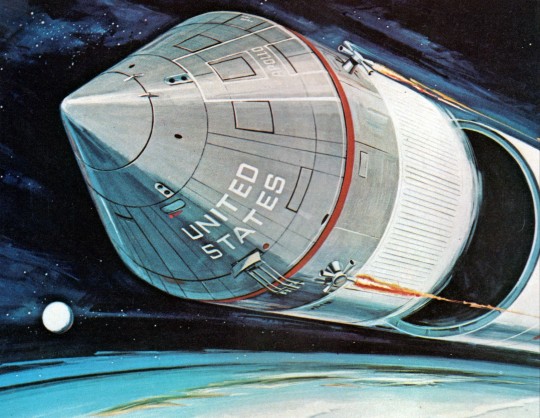
Early concept art of the Apollo Block I Command and Service Module separation from the S-IVB.
Image from Space Horizons Vol. No. 1, Issue No. 1 (1965)
By the later summer of 1963 the value of the Saturn I missions seemed increasingly in doubt. The limited payload of the Saturn I meant that only partial systems could be installed. At a September 26, 1963 meeting in Washington, D.C., NASA's scheduling contractor, Bellcomm, was asked to develop an Apollo mission assignment program without a Saturn I.
Bellcomm quickly responded, recommending that the Apollo spacecraft flight test program should be transferred from the Saturn I to Saturn IB launch vehicles. The Saturn I program should end with flight SA-10. All Saturn IB flights, beginning with SA-201, should carry operational spacecraft, including equipment for extensive testing of the spacecraft systems in earth orbit. Associate Administrator for Manned Space Flight George E. Mueller recommended the changeover on October 26. NASA Administrator James E. Webb's concurrence came two days later. Development of the Saturn IB for manned flight would be accelerated and 'all-up' testing would be started.
No crew assignments were ever made for these flights; the first two groups of astronauts were fully committed to the Gemini program. The third astronaut selection, in October 1963, was simultaneous with the decision to drop the Saturn I flights. Had these flights occurred, they would have run from fall 1965 to the end of 1966, concurrent with the flights of Gemini 5 to 12."
Cancelled missions:
SA-11 (AS-106): planned launch Winter 1965
SA-12 (AS-107): planned launch Spring 1966
SA-13 (SA-108): planned launch Summer 1966
SA-14 (AS-109): planned launch Fall 1966
-Information from Astronautix.com: link
Posted on Flickr by Numbers Station: link
#SA-11#(AS-106)#SA-12#(AS-107)#SA-13#(AS-108)#SA-14#(AS-109)#Saturn I#Saturn I Block II#Rocket#NASA#Apollo Program#Apollo-A#Apollo CSM Block I#1965#1966#Cancelled#Cancelled Mission#my post
56 notes
·
View notes
Text

What Apollo 1 Command and Service Module (CSM-012) would have looked like if everything went as planned.
Render of the Apollo CSM Block I by T. Muto, 2001. Unlike the later Block II, this capsule lacked a docking port, among other things.
source, source
#Apollo 1#AS-204#Apollo CSM Block I#CSM-012#Saturn IB#SA-204#Rocket#NASA#Apollo Program#C-type Mission#February#1967#what if#Earth#Space#Artwork#Cancelled#Cancelled Mission#my post
32 notes
·
View notes
Text
Cancelled Missions: Apollo AS-204 (aka Apollo 1)

Planned Launched: February 21, 1967
Commander Pilot:CDP Virgil I. Grissom
CM Pilot:CMP Edward H.White.II
LM Pilot:LMP Roger B. Chaffee
The tragic fire that claimed the lives of Gus Grissom, Ed White and Roger Chaffe and postponed the debut manned flight of the Apollo Spacecraft. The Apollo AS-204 was cancelled as NASA officials investigated the cause of the fire and came up with changes to the block II Command Module, set to debut now on Apollo 7. Set back Apollo program by 18 months. This deserves its own post
Here is what was originally planned for the first manned mission (C-type) of the Apollo Command and Service Module:
"Originally planned for the last quarter of 1966. Numerous problems with the Apollo Block I spacecraft resulted in a flight delay to February 1967. The designation AS-204 was used by NASA for the flight at the time; the designation Apollo 1 was applied retroactively at the request of Grissom's widow.
Apollo 205, a second solo flight test of the Block I Apollo CSM, was planned but cancelled on December 22, 1966. The Schirra, Cunningham, Eisele crew from that flight became the backup crew to Apollo 204 (replacing the original backup crew of McDivitt, Scott, Schweickart)."
-Information from Astronautix.com: link
One proposal was to launch Gemini 11 (or 12 or both) and Apollo 1 at the same time and rendezvous in orbit. If the first two Apollo missions (AS-201 and AS-202) were a failure, then AS-204 (AS-203 did not carry a CSM) would be flown unmanned and a Gemini astronaut would EVA transfer to and enter the CSM-012, check out its systems, and return to the Gemini. However, with the delays with getting CSM-012 ready, having to reconfigure the Gemini capsule to work with Apollo and the eagerness to finish Gemini to focus on Apollo, this proposal was cancelled.

"The Apollo 1 prime crewmembers for the first manned Apollo Mission (204) prepare to enter their spacecraft inside the altitude chamber at the Kennedy Space Center (KSC). Entering the hatch is astronaut Virgil I. Grissom, commander; behind him is astronaut Roger B. Chaffee, lunar module pilot; standing at the left with chamber technicians is astronaut Edward H. White II, command module pilot."
"For the first two and a half hours in orbit, CSM-012 would remain attached to the S-IVB stage much as a Moon-bound Apollo would do prior to trans-lunar injection. After separation of the CSM, Grissom would perform a station keeping exercise with the spent S-IVB stage so that White and Chaffee could photograph the stage as it vented its residual propellants. This would provide vital observations on the behavior of the S-IVB stage to aid in planning future mission activities.
At this point, Apollo 1 would perform an open-ended mission which could last for as little as six orbits in order to meet at least the highest priority mission objectives or as long as two weeks, provided that CSM-012 continued to function adequately. The primary objectives of the mission basically centered on testing all the systems of the Block I Apollo spacecraft during ascent, in orbit and during descent. The first pair of firings of the SM’s SPS would take place the day after launch to raise and circularize the orbit of Apollo 1. No attempts would be made to perform a rendezvous with the spent S-IVB stage. Afterwards, burns of the SPS were planned to be performed every other day during the course of the mission with each astronaut taking turns in the left-side commander’s seat – three burns each by Grissom and White as well as two burns by Chaffee. Apollo 1 would carry a television camera which would allow live broadcasts from inside the CM cabin during the mission. The camera would also allow ground controllers to monitor the CM’s control panel during key parts of the flight.
In addition to the laundry list of systems checks, Apollo 1 also carried an array of hardware to perform a total of nine medical, scientific and technological experiments during its long orbital mission. These consisted of the following:

The storage locations of some of the hardware for flight experiments inside the Apollo 1 cabin.
M-3A In-Flight Exerciser: This was simply a pair of bungee cords that would loop around the astronaut’s feet and grasped by the hand via a handle. Each astronaut would spend three ten-minute sessions each day exercising with this device to determine the utility of in-flight exercise to stave off the effects of prolonged weightlessness. A similar M-3 experiment was flown on the Gemini 4, 5 and 7 long-duration missions during 1965.
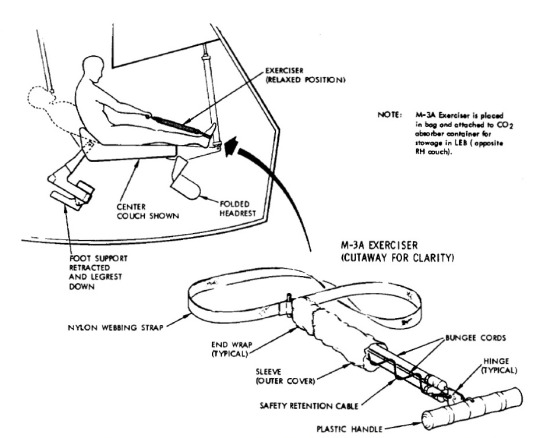
Diagram showing the M-3A exercise experiment that would have been carried by Apollo 1.
M-4A In-Flight Phonocardiogram: The purpose of this experiment was to produce in-flight recordings of the crew’s heartbeat to determine the effects of weightlessness on heart function. Grissom and Chaffee would be the subjects of these tests. This was similar to the M-4 experiment flown on the long-duration Gemini missions.
M-6A Bone Demineralization: The goal of this experiment was to determine the effects of weightlessness on the demineralization of certain bones in the body. This experiment required no special in-flight equipment and would rely on measurements derived from X-rays taken before and after the flight from all three crew members. Once again, this was similar to the M-6 experiment performed during the long-duration Gemini missions.
M-9A Human Otolith Function: The objective of this experiment was to determine the effect of prolonged weightlessness on an astronauts sense of orientation. Each crew member would spend 15 minutes each day in orbit wearing a set of test goggles with their responses recorded by a 16 mm movie camera. A similar experiment was conducted during the Gemini 5 and 7 missions.
M-11 Cytogenetic Blood Studies: This experiment sought to determine if the space environment produced cellular changes in the blood of the crew. No in-flight equipment was required with the necessary data coming from blood samples taken from all three crewmen at set intervals before and after the mission.
M-48 Cardiovascular Reflex Conditioning: In this experiment, one of the astronauts would don a set of vascular support tights one or two hours before the end of the mission to determine if such a garment helps prevent physical fatigue blood pooling in the lower body following return to Earth.
S-5A Synoptic Terrain Photography: This was similar to the S-5 experiment flown on most of the earlier Gemini missions. The crew would use a 70 mm Hasselblad camera to perform near nadir-viewing photography of the Earth during 9 AM to 3 PM local time. Two color film packs with a total of 110 exposures were to be carried on the Apollo 1 mission.

Diagram showing the in-flight stowage of the camera and film packs for the S-5A and S-6A experiments on the inside CM crew hatch.
S-6A Synoptic Weather Photography: Similar to the S-6 experiment conducted on most of the Gemini missions, the purpose of this investigation was to provide orbital photographs of weather phenomena at a much higher resolution than was possible with contemporary weather satellites like NASA’s TIROS or Nimbus satellites. One color and one color-shifted infrared film packet along with an ultraviolet filter for the camera would be carried to support this experiment.
T-3 In-Flight Nephelometer: This experiment used a device to measure the size, concentration and distribution of particles present inside the CM cabin. Measurements would be made every six hours starting two days into the mission."
-Information from DrewExMachina: link
The mission was scheduled to last about 2 weeks and would have been recovered by USS ESSEX (CV-9) in the Pacific Ocean on March 7, 1967.
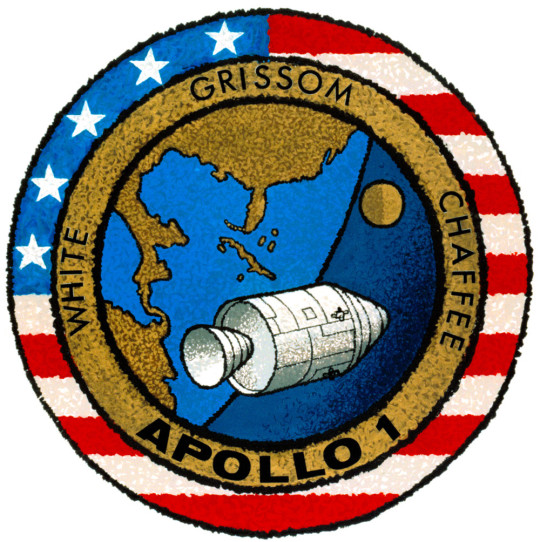
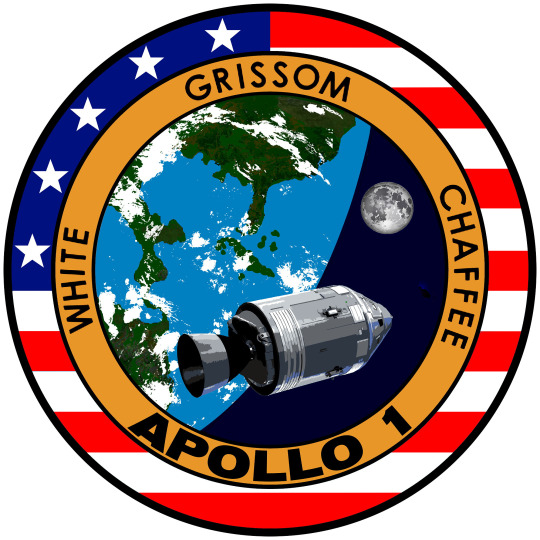
- Apollo 1 mission patch
NASA ID: S66-30236, S66-58038, S66-36742
source, source
#Apollo 1#AS-204#Apollo CSM Block I#CSM-012#SLA-5#Saturn IB#SA-204#Rocket#NASA#Apollo Program#C-type Mission#February#1967#Cancelled#Cancelled Mission#my post
66 notes
·
View notes
Text

An Apollo Block I Command Module (CM) being mated to a Service Module (SM) at North American Aviation's Downey facility. Based on the date, this most likely Apollo 6's CSM, so it is SM-017 and CM-020. This reason the mismatched CM and SM was due to available hardware. SM-020 was used for Apollo 4 after its SM, SM-017, was damaged in an explosion and had to be scrapped. CM-014 was unavailable for flight as it was being used to aid the Apollo 1 investigation.
Date: December 27, 1966
NASA ID: S67-15721
#Apollo 6#Apollo CSM Block I#CSM-020#NASA#Apollo Program#A-type Mission#Construction#North American Aviation#Downey#California#December#1966#my post
43 notes
·
View notes